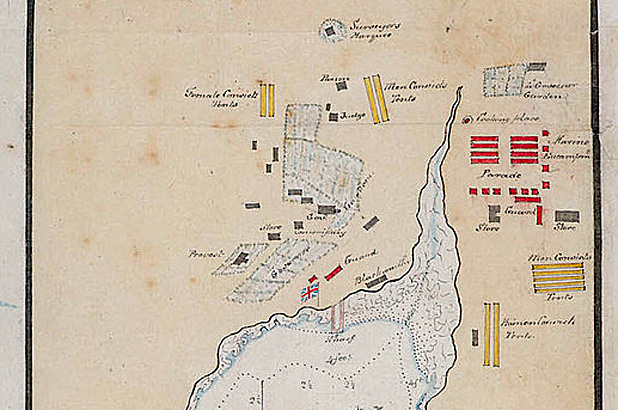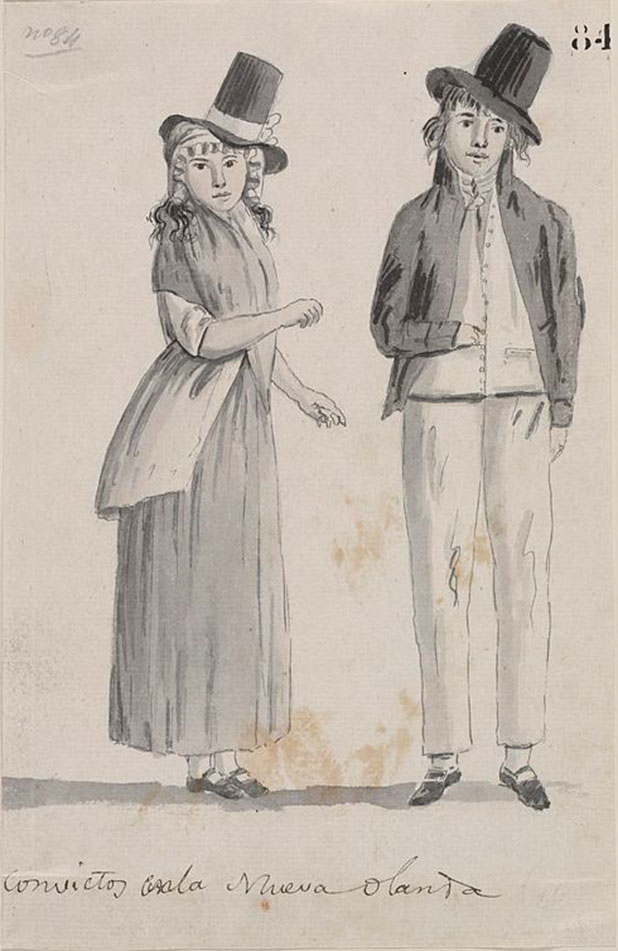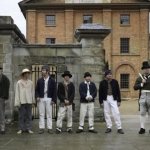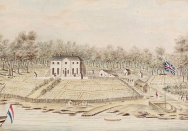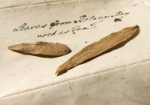Early Sydney operated surprisingly freely. It was effectively a jail without walls where, rather than being imprisoned, the convicts were the general population, living as a community in tents at first, then in huts and cottages that they built themselves.
The map above gives an idea of how the fledgling ‘encampment’ began to take shape (you can see the full map at the State Library of NSW). Communal ‘cooking places’ were set up (note the little red ‘bullseye’ above the marines’ camp near the rivulet) and bakehouses where flour could be exchanged for baked bread loaves. Some dwellings had ovens, built from stones gathered locally or, later, from clay bricks but simple campfire cookery was the general norm. The convicts were supplied with basic utensils. Three-legged iron pots were the universal cooking utensil (a precursor to the bushman’s ‘billy’), but these were coveted, as they were often damaged, lost or stolen. Governor Phillip complained of a shortage of shovels in the colony, as most of them were being used as frying pans!
Domestic bliss
Marines generally lived in barracks, but most people lived as couples, family groups, flatmates and, as more females arrived, some convict workers were lodged in a more organised way with groups of eight or ten living in a communal hut, often with a female housekeeper. Some convicts lodged with officers or families as domestic help. So long as convicts completed their designated tasks or working duty each day, they were able to use the rest of the day as their own time – ideally to tend their gardens or work for the government or others for extra income. As there was no hard currency in the colony, income was often food, tobacco, luxuries such as tea and sugar if available and, despite being illegal, the ever-popular liquid currency – rum.
Keeping control
As my previous post explained, it was the government’s responsibility to furnish each person with a food allowance, or rations. This was no minor undertaking and was a significant organisational challenge. It’s no coincidence that the storehouses were strategically placed next to the soldiers’ camp – the Commissariat was responsible for keeping the provisions safe and secure from the effects of damp and pests or vermin, including the two-legged kind – convicts and marines! The Commissariat was also charged with monitoring the condition and available quantities against demand, which waxed and waned depending on supply, and distributing the rations according to the Governor’s orders. Albeit something of a logistical nightmare, controlling the food supply meant the authorities exercised significant power over the rations’ recipients. Regulated provisioning was a good way to ensure a convict turned up for work and behaved well, and collecting rations from a central store twice a week worked as a type of muster process, ensuring no-one had absconded.
A wily lot – resourceful and opportunistic
Convicts had access to native foods but there were limitations: all meat caught had to be surrendered to the government authorities and of course convicts were denied access to guns or boats, so hunting and fishing was almost impossible. Fresh fish and wild game were traded with Aboriginal people who began to frequent the settlement and inevitably there was a thriving black market! It also meant the convicts were very opportunistic:
Mon. 2nd [June, 1788]
About a Week ago, a fine She Goat belonging to one of Gentlemen, was found Dead, and some of the Fleshy Parts cut off, and to Day two Men were taken up on Suspicion of having killed this Goat, and made a Pie of some part of it, but it appeared that they found the Goat dead, its Entrails torn out and otherwise mangled as if some Animal had been eating of it, and as it was at this time perfectly sweet, and one of the Men was to be married the next Day, they took the Liberty of cutting some of the Meat off, to make a Pie for the Wedding-Dinner.
Worgan, George B. Journal of a First Fleet Surgeon. 1788.
Imported livestock were heavily protected, but there were native alternatives:
‘The opossum, of which there is a great number… eat very well … we sometimes get … cangaroos [sic]… to buy for sixpence per pound, but it must be done privately, as the governor will not allow it’. (Cobley p167)
In their ‘spare’ time, convicts were encouraged to tend their gardens – note on the map above how quickly the garden plots had been established within just a few weeks after arrival. They could forage for native greens or edible berries in the surrounding ‘woods’ as they described the native bushland, and comb the shoreline for shellfish. Cockle Bay, now a popular restaurant precinct, just over the ridge to the west of the settlement, proved a popular hunting ground as indicated by its title. One unknown female convict wrote of the local fare,
Our kingaroo [sic] rats are like mutton… there is a kind of chickweed that is so much in taste like our Spinach that no difference can be discerned… Something like ground Ivy is used for tea. (Heney p1)
The native spinach was most probably Tetragonia tetragonoides, sometimes called ‘Botany Bay’ greens, or today, warragul (warrigal) greens, a crop of which is always growing in the kitchen garden at Vaucluse House if you’re curious to try them. We’ll talk more about the ‘ground ivy’ later this month, but it is worth noting that the colonists were selecting produce that fitted in with their expectations of familiar foods from home – fish and shellfish, meat, greens and tea. And for those with less adventurous tastes, or poor luck finding fresh alternatives, salt pork was the staple.
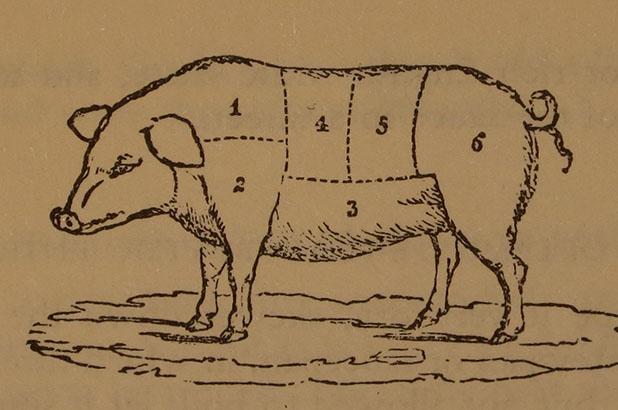
Pork illustrated in Eliza Acton, Modern cookery for private families, Southover Press, Lewes, 1993 (1st ed.1845), p218. Caroline Simpson Library & Research Collection, Historic Houses Trust
In case you were wondering how salt pork was produced, here is a description of the process from 1805. It’s not one to consult if you’re squeamish, and I don’t suggest trying this at home!
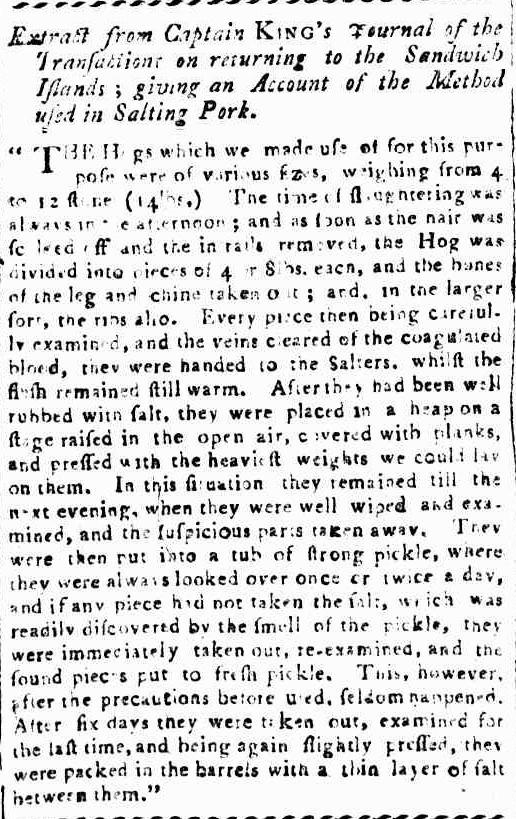
‘Method of salting pork’ in the Sydney Gazette October 6, 1805. accessed via Trove, National Library of Australia.
Sources:
Heney, Helen. 1985. Dear Fanny: Women’s Letters to and from New South Wales, 1788-1857. Pergamon Press (Australia) Pty Ltd. p1 letter dated November 14, 1788, author unknown.
Unknown author, 24 November 1791, cited in Cobley, John. Sydney Cove, 1791-1792, Sydney, 1986 [1965], p. 167.
